Articles Menu
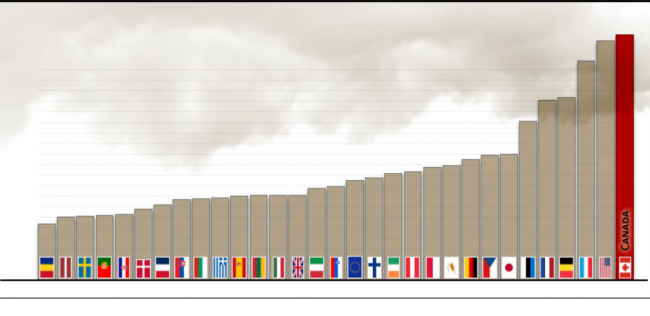
July 27, 2022
Burning fossil fuels is the root cause of climate breakdown, ocean acidification and the choking air pollution that is killing millions every year.
For more than 30 years, Canada has been promising to do its part in solving these crises by reining in our hugely oversized fossil fuel burning. Instead, we keep cranking up the amount we burn. That's according to the data in the latest BP Statistical Review of World Energy.
This data also shows that Canada is dragging its feet on expanding climate-safe and less-deadly energy sources that we need to switch to — like hydro, nuclear, wind and solar. As a result, fossil fuels’ formidable lead in Canada’s energy use keeps growing.
Canadians now burn more fossil fuels per person than any of our peer nations in the wealthy Group of Seven (G7) or the European Union. And while nearly all these nations have managed to reduce their climate pollution since 1990, Canada hasn’t. We still emit far more.
Canada’s multi-decade failure to reduce fossil fuel burning has left Canadians and our economy increasingly exposed to the rapidly metastasizing climate crisis.
To illustrate Canada’s ever-growing fossil fuel problem, I’ve created a series of charts using the latest BP energy data.
My first chart lets you compare Canada’s energy use last year to what we used back in 1990, the year Canada first promised to reduce climate pollution.

Back then, Canadians burned seven exajoules of fossil fuels.
(Note: An "exajoule" (EJ) is an energy metric used by BP and others to compare different sources of energy. It is roughly equal to the energy from burning 163 million barrels of oil.)
Over the next 30 years, instead of reducing our carbon burning as promised, we kept cranking it up. Last year, we burned nine exajoules worth of fossil fuels — two more than in 1990.
For scale, the combined nations of Central America currently burn about one exajoule worth of fossil fuels each year. So, Canada has increased its fossil fuel burning by two Central Americas worth since 1990. That’s the path to a chaotic climate future, not a safe one.
The chart’s green bars show how much climate-safe energy Canada uses. This increased by just one exajoule — only half as much.
Canada’s multi-decade failure to reduce fossil fuel burning has left us and our economy increasingly exposed to the rapidly metastasizing climate crisis. #ClimateCrisis #cdnpoli #FossilFuels @saxifrages writes for @NatObserver - Twitter
As my next chart highlights, fossil fuels' already formidable lead over cleaner alternatives has grown even larger.
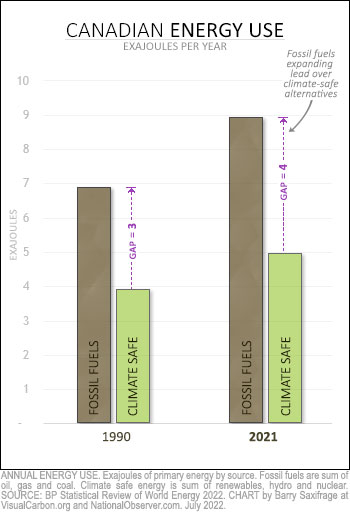
Back in 1990, fossil fuels had a three exajoule lead over climate-safe energy sources in Canada. Now, the gap has grown to four exajoules.
Three decades ago, the climate task facing Canadians was to eliminate seven exajoules of fossil fuel energy. That’s a lot of energy to replace or cut back. But back then, we also had several decades ahead of us to engineer a graceful energy transition.
Instead of acting, Canada burned up precious decades while making the problem even larger. Today, Canadians face a much larger task — eliminating nine exajoules per year worth of fossil fuels. And we have far less time remaining to do it. The climate crisis is now hammering away with increasing fury on our communities, food supply, security, economy and the rich ecosystems we cherish and depend on.
The impacts will keep growing more dangerous until we’ve eliminated all fossil fuel burning.
There is one form of fossil fuel that Canada has acted on — coal burning in power plants.
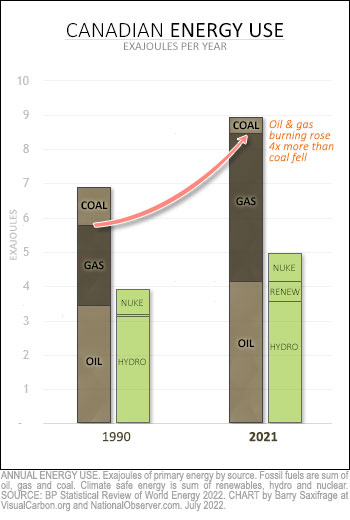
This effort was led by Ontario with its Cessation of Coal Use Regulation back in 2007. The provincial government calls this the "single largest greenhouse gas (GHG) emissions reduction action on the continent." It remains Canada’s biggest climate success so far.
But, as this next chart highlights, all of Canada’s hard-won climate progress from coal cuts was wiped out four times over by our huge surge in oil and gas burning.
For those who like geeky details, coal burning declined by 0.7 EJ, while oil and gas burning surged by 2.7 EJ.
One step forward, four steps back.
On the positive side, Canadians are close to eliminating coal-burning power plants. Less than half an exajoule of coal burning remains. And Canada has laws on the books to shut down most of that.
But the flip side is that Canada has now played its coal card and, yet, fossil fuel burning continues to rise.
To make any meaningful climate progress now, Canada must make large and rapid cuts in our oil and gas burning. These now total 95 per cent of our fossil fuel burning.
However, Canada has been green-lighting economic and climate policies that do the opposite. Both oil and gas burning have risen relentlessly in Canada. Both hit all-time highs in 2019.
So far, the only thing that has slowed down Canada’s fossil burning has been two major global crises.
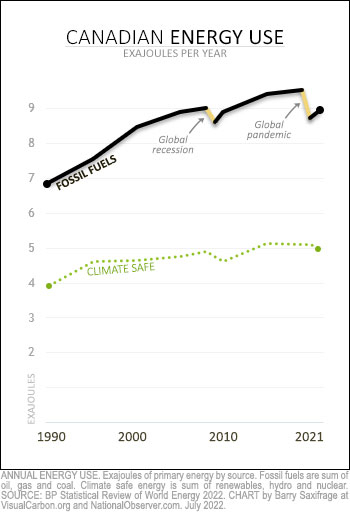
In 2009, the sudden global financial meltdown turned down Canada’s fossil burner — for a single year. And in 2020, the global COVID pandemic did it again.
But even these global crises were just temporary speed bumps in Canada’s determined acceleration off the climate cliff. In both cases, fossil burning rebounded strongly the next year.
In fact, it took just one year for Canada's fossil gas burning to erase the pandemic dip and surge to a record high in 2021.
Both these global economic crises also put a damper on Canada’s climate-safe energy. According to the BP data, Canada’s climate-safe energy peaked in 2017 and has been struggling through years of decline since.
Overall, though, Canada’s energy trends have been remarkably stable since 1990. Fossil fuel burning keeps rising. And it keeps rising much faster than climate-safe energy. The gap between climate-safe energy and climate-destructive energy keeps growing larger. And the amount of fossil fuel burning that Canadians must eliminate to preserve a livable climate keeps growing larger as well.
There is no sign in this data that Canada is turning the corner on its fossil fuel addiction.
So far, we’ve looked at the total fossil fuel burning in Canada.
Another revealing comparison I found in the BP data is in the amount of fossil fuels burned per person.
My next chart shows fossil fuel burning per capita among Canada’s peers in both the G7 and the European Union. Combined, these 31 nations hold more than half the world's wealth, produce half the global GDP, and emit a third of the climate pollution.
Where are Canadians?

Yep, sadly, we are in first place — burning the most per person.
Canadians now burn nearly four times more fossil fuels per person than the global average; triple the French or British; and more than twice as much as the Germans and Japanese. Heck, even the Americans now burn less per person than we do. They used to burn a lot more than we did, but even the land of Trumpian climate denial and yahoo oil cowboys now burns less than us.
And, of course, all our oversized fossil fuel burning comes with oversized heaps of climate pollution.
My final chart shows the climate progress these same nations have made since 1990.
Green bars show reductions in climate pollution. As you can see, nearly all our peers in this group have reduced their emissions. Not Canada. We are one of the few climate rogues — still polluting more.
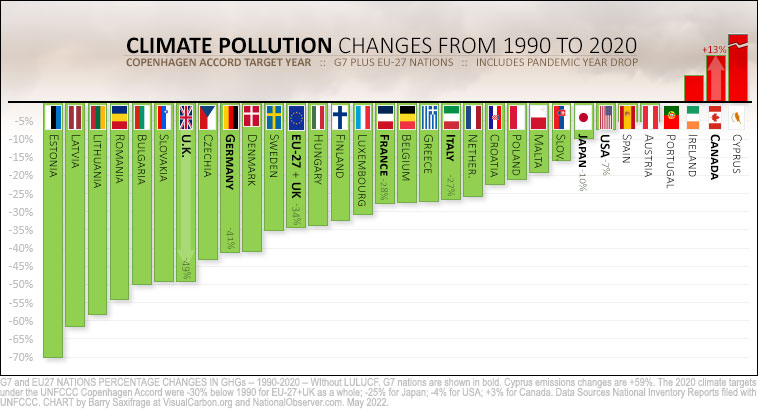
The Europeans have cut their climate pollution — by a third.
The British have cut their climate pollution — in half.
We’ve cranked ours higher. Is this really who we want to be?
If Canadians ever want to get off our treadmill of rising fossil fuel addiction and endless climate failure, we could adopt the same carbon budget policies that have been working so well for our Commonwealth peers in the U.K.
At this point, we know what works and what doesn’t.
Continuing with climate arson isn't our only option. We can choose a different and more hopeful path.
[Top chart: Fossil fuel burning keeps rising in Canada, and Canadians now burn more per person than any of our peers in G7 and European Union nations.]